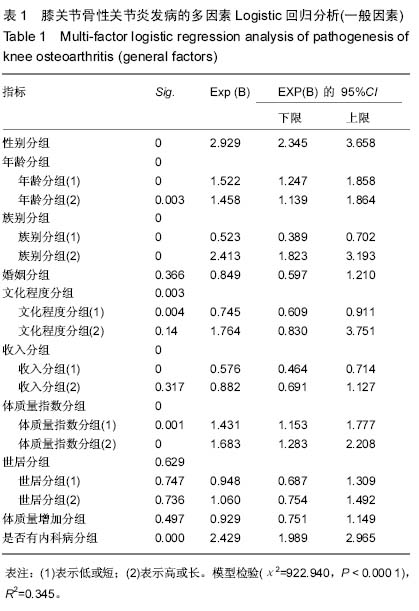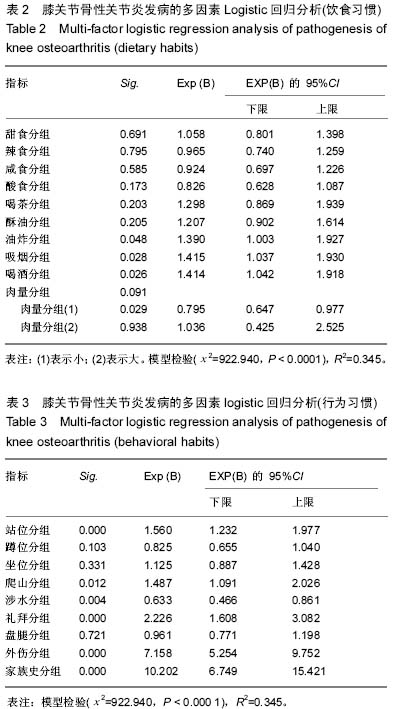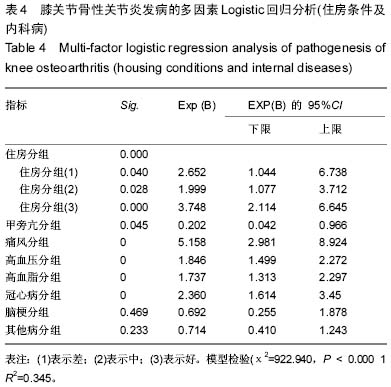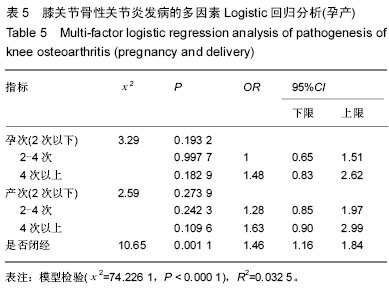中国组织工程研究 ›› 2015, Vol. 19 ›› Issue (29): 4614-4618.doi: 10.3969/j.issn.2095-4344.2015.29.005
• 骨组织构建 bone tissue construction • 上一篇 下一篇
新疆北疆牧区维、哈、汉族膝骨性关节炎致病因素的流行病学调查
沈明球1,刘俊昌1,王新军2,张彦峰1,张超凡1,马鑫文1,栾 立1
- 新疆医科大学附属中医院推拿科,新疆维吾尔自治区乌鲁木齐市 830001
An epidemiological investigation on the pathogenic factors of knee osteoarthritis in Uygur, Kazakh and Han populations in pastoral areas of northern Xinjiang Uygur Autonomous Region, China
Shen Ming-qiu1, Liu Jun-chang1, Wang Xin-jun2, Zhang Yan-feng1, Zhang Chao-fan1, Ma Xin-wen1, Luan Li1
- Department of Massage, Affiliated Hospital of Traditional Chinese Medicine, Xinjiang Medical University, Urumqi 830001, Xinjiang Uygur Autonomous Region, China
摘要:
背景:在新疆地区农牧民生活水平普遍明显低于城镇居民,同时当地缺医少药,医学知识匮乏是当地农牧民们罹患骨关节病的主要原因,大多农牧民不能够在早期发现或预防膝关节骨关节炎,去除致病因素,致使其在就医时病情严重。 目的:了解新疆北疆农牧区维、哈、汉3个民族膝关节骨性关节炎主要致病因素。 方法:在2012年1月至2013年12月采用分层、多阶段、整群随机抽样的方法,随机抽取北疆维吾尔族、哈萨克族、汉族3个民族符合条件的常住居民,对符合纳入标准的所有居民以入户现场封闭式问卷的方法进行膝关节骨性关节炎的调查,对有症状者进行膝关节X射线正侧位平片检查。建立数据库,采用SPSS 20.0软件对其中40个变量进行多因素非条件 Logistic 回归分析。 结果与结论:共调查3 540例,有效问卷3 402份。回归分析得出维吾尔族、哈萨克族、汉族之间共同致病因素有:年龄大、女性、体质量高和是否饮洒有关;吸烟、内科病病史、文化程度高、站位、爬山、外伤、家族史、油炸食品、住房条件以及妇女是否闭经、不同族别、少数民族做礼拜也是主要危险因素;在3个民族中维吾尔族、哈萨克族女性患病率明显高于汉族;3个民族之间患病率不同;而饮食偏好尚不能确定是膝关节骨性关节炎的相关影响因素,出行方式、居住地气候环境、孕产次数、是否喝茶及喝茶的种类与膝关节骨性关节炎是否有关尚不明确。 中国组织工程研究杂志出版内容重点:人工关节;骨植入物;脊柱;骨折;内固定;数字化骨科;组织工程
中图分类号:



